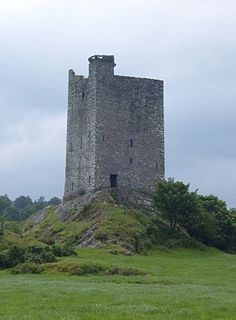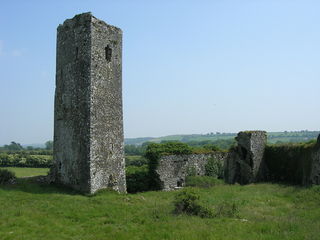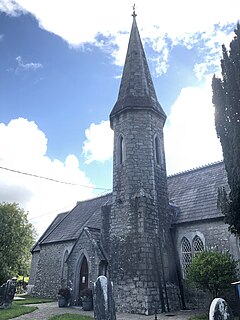
Carrigrohane Castle is located in the village of Carrigrohane, barony of Barretts in County Cork, Ireland. It is situated on a rocky cliff-edge which overlooks the River Lee.

Carrigrohane Castle is located in the village of Carrigrohane, barony of Barretts in County Cork, Ireland. It is situated on a rocky cliff-edge which overlooks the River Lee.
The castle's original construction is attributed to the MacCarthy family. [1] The castle became dilapidated in 1641 during the Irish Confederate Wars. It was repaired thereafter and became the residence of the rapparee, Captain Cape, and his bandits, who waylaid travellers, and plundered the surrounding countryside. [1]

By the late 18th century it had fallen into ruin, and a mid-19th century description of the castle describes it as consisting of "two structures differentiated by age, altitude, bulk, and architecture - the larger and older of which is oblong, and three-storied". [1] The castle was restored in the mid-19th century, reputedly by Thomas Newenham Deane and Benjamin Woodward. [2] Additional renovation works were undertaken in the 20th century, and the castle used as a family home from the late 20th century. [3] [4]
A cave at the base of the rock on which the ruin stands is believed by local residents to communicate with the Ovens caverns, 4 miles (6.4 km) away. A deep pool, called Hell's-Hole, overhung by limestone cliffs, and situated at a river bend above the castle site is imagined to be haunted by a "monstrous biped, having a mane like a horse, and a body like an eel". [1]

Dunboy Castle is a ruined 15th century castle on the Beara Peninsula in south-west Ireland near the town of Castletownbere. The castle's tower house and bawn were destroyed in the 1602 Siege of Dunboy, though its ruins remain open to the public.

Castlemartyr is a village in County Cork, Ireland. It is located 25 minutes east of Cork city, 10 km (6 mi) east of Midleton, 16 km (10 mi) west of Youghal and 6 km (4 mi) from the coast. Approximately 1,600 people live in the village and its hinterland. It is situated on the N25 national primary road.

Benjamin Woodward was an Irish architect who, in partnership with Sir Thomas Newenham Deane, designed a number of buildings in Dublin, Cork and Oxford.

Dromore Castle is a manor house in Templenoe, County Kerry, Ireland, looking out over the Kenmare River. It was built in the 1830s for the Mahony family to a neo-gothic design by Sir Thomas Deane.
Sir Thomas Newenham Deane was an Irish architect, the son of Sir Thomas Deane and Eliza Newenham, and the father of Sir Thomas Manly Deane. His father and son were also architects.

Glanworth is a village on the R512 regional road in County Cork, Ireland. It lies approximately 8 kilometres (5 mi) northwest of the town of Fermoy and 40 km (25 mi) northeast of Cork city. As of 2016, Glanworth's population was 603.

Castletownroche is a townland, village, and civil parish in the barony of Fermoy, County Cork, Ireland. It is located on the N72 national secondary road. In ancient times, it was known in Irish as Dún Chruadha, meaning Cruadha's Fort. Castletownroche is located on the River Awbeg in the Blackwater Valley about eight miles (13 km) from Mallow. Castletownroche is within the Cork East Dáil constituency.

Belvelly Castle is a 14th or 15th-century tower house in County Cork. It is situated next to the small village of Belvelly, opposite and overlooking the only road bridge connecting Fota Island to Great Island.

Carrigaphooca Castle, is a ruined five storey rectangular tower house situated on a steep-sided rock overlooking the River Sullane. It is located 6 km west of Macroom, County Cork, Ireland, in an area once known as Gleann na n-Dearg. The tower dominates the landscape of Lissacresig (Fairyland) in Clondrohid, and Lower Shanballyshane, in Kilnamartyra. Carrigaphooca is made of sandstone and limestone and was built as a defensive tower by MacCarthy clan member Donal MacCarthy of Drishane c. 1336-51.

Ballincollig Castle is a Norman castle to the south of the town of Ballincollig, County Cork, Ireland built after the Norman invasion of Ireland. In its prime, the castle was inhabited by the Barrett family, who had control of the local area. The castle still stands today, albeit largely in ruin. The original keep still remains, as does most of the curtain wall and two towers.
Blackrock is a suburb, with a village core, in the south east of Cork City, Ireland. Originally a small fishing village about five kilometres from Cork City, the growth of the city over time has meant that the village has become incorporated into the city. It is home to Blackrock GAA club, Blackrock Castle, a weekly farmers market, and as of 2015 has seen some investment in regeneration projects for the traditional village centre. Blackrock is within the Cork South-Central Dáil constituency.
Affane is a small village in west County Waterford, Ireland, situated near Cappoquin and the River Blackwater.
Clan Barrett is an Irish clan from County Cork that originally descended from Norman invaders who travelled through England and Wales with William the Conqueror in the 12th century, and then into Ireland with Strongbow in the 13th century. They are often thought to be related to the ancestors of the similarly-named Clan Barrett of the mountainous Mayo-Galway areas, who are otherwise considered Gaelic in origin. Of the two, the Cork branch was considered numerically stronger, while the Mayo-Galway branch held more prominence in the Middle Ages.

Carrigrohane is a village and civil parish situated on the south bank of the River Lee to the west of the city of Cork in Ireland. It is connected by the Carrigrohane Straight, 4 miles (6.4 km) west of Cork and is also in the northeastern part of Ballincollig. It contains St Peter's Church of the Resurrection. In 1837, it had a population of 1921 inhabitants. The civil parish is almost evenly split between the baronies of Muskerry East to the west and the Barony of Cork to the east.

The Church of St Peter, Carrigrohane, is a Gothic Revival church in Cork, Ireland. It belongs to the Church of Ireland and was constructed in 1854, and extended by William Burges in 1865-68. The church is located on Church Hill, Carrigrohane, to the west of Cork city. It stands on the site of an earlier church, and is dedicated to Saint Peter. Along with the Church of the Resurrection and St Senan's Church it is part of the Carrigrohane Union of Parishes in the Diocese of Cork, Cloyne, and Ross.

Dundanion Castle is a Tudor tower house in the Blackrock area of Cork in Ireland. Previously known as Galwey's Castle, the ruin is located on the grounds of the much later "Dundanion House".

Coppingers Court is a ruined four storey fortified house dating from 1616, situated on private property approximately half a mile (0.8km) from the sea. It was built by Sir Walter Coppinger and located in Ballyvireen valley, west of Rosscarbery in County Cork Ireland. The house has a rectangular centre flanked by two wings on the east and west, resulting in a total of 9 gables.

Dripsey Castle is a country house in the townland of Carrignamuck, situated 3.3 km (2.1 mi) north-east of Coachford village and 2.5 km (1.6 mi) north-west of Dripsey village. The house and demesne were dominant features in the rural landscape of Ireland, throughout the eighteenth and nineteenth centuries. Location often reflected the distribution of better land, and this is evidenced in mid-Cork, where many of these houses are situated along the valley of the River Lee and its tributaries.

Castlefreke, also known as Rathbarry, is a townland and village in County Cork, Ireland. The townland is located in the civil parish of Rathbarry on the R598 regional road, to the east of Rosscarbery.

Shandon Castle, originally known as Lord Barry's Castle, was an early medieval castle in the Shandon area of Cork city in Ireland. It was built in the late 12th century by Philip de Barry, close to an earlier ringfort. Located outside the city's gates and defensive walls, the castle was a seat of the Cambro-Norman de Barry family for several centuries.
[John] Windele noted in the early 1840s that only its walls remained. It is thought to have been restored by Deane and Woodward from 1849-50